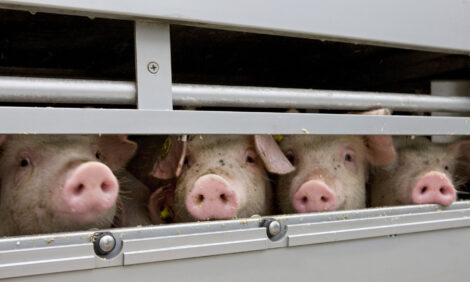



Needle-free Vaccination Lifts Performance on Longford Pig Farm
IRELAND - Improved weight gains in both weaners and finishers, as well as easier application and less stress on the pigs are among the benefits noted by the owners after the switch to an intradermal vaccine on the Brady family pig unit in Longford, Ireland.The IDAL (Intradermal Application of Liquids) gun can be used for administering Porcilis® PCV ID, the vaccine that protects against PCV2 (Porcine circovirus type 2), one of the major disease threats in Irish and UK pig production.
Dermot Brady and his father Donal, who run a 2,000-sow integrated unit, started using the IDAL gun for PCV2 vaccination last March and are very happy with the results.
“The needle-free system is much easier to use and is less stressful on the pigs. It eliminates the risk of broken needles which can result in needle pieces remaining in the tissues, causing serious issues during and after processing. There is also less risk of transmitting disease from pig to pig,” said Dermot.
“The IDAL system involves giving a low volume injection of just 0.2ml of Porcilis® PCV ID to each piglet. Another big advantage is the flexibility of the vaccination site. Rather than being confined to the neck it can be given at side of the neck, along the muscles of the back or in the hind leg,” he said.
Performance
The Bradys were previously using a different vaccine, administering a 1ml dose at 14 days old using needles. Since switching to the low volume Porcilis® PCV ID needle-free system, they have experienced a significant improvement in pig performance.
“Our weaners have gone up by around 30g/day and are now approaching 700g/day. The performance of our fatteners has gone up by as much as 50g to around 1,000g/day. This is a very significant and a welcome improvement,” said Dermot.
Highlighting the risks of PCV2 infections in pig production, Ricardo Neto, Technical Manager with MSD Animal Health (UK and Ireland), said that “the disease is present in most Irish and UK pig units and multiplies quickly in individual pigs. Unfortunately, infections produce signs such as weight loss or lack of thrive, difficulty breathing, diarrhoea, pale skin and jaundice.”
Immunity
“Porcilis® PCV ID, given at three weeks of age or older, reduces viraemia and subclinical PCV2 during the finishing period. Its duration of immunity is 23 weeks after vaccination,” said Ricardo.
MSD Animal Health (known as Merck Animal Health in the United States and Canada) is leading the field in the development of advanced vaccination technologies. With intradermal vaccines already available for M. hyo (Mycoplasma hypopneumoniae) and PRRS virus (Porcine reproductive and respiratory syndrome virus), last year’s launch of Porcilis® PCV ID means that pig producers now have the most advanced vaccination methods available to deal with three of the most important diseases affecting their business.









